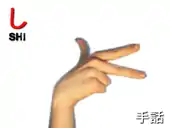Shi (kana)
し, in hiragana, or シ in katakana, is one of the Japanese kana, which each represent one mora. Both represent the phonemes /si/ although for phonological reasons, the actual pronunciation is [ɕi] (![]() listen). The shapes of these kana have origins in the character 之. The katakana form has become increasingly popular as an emoticon in the Western world due to its resemblance to a smiling face.
listen). The shapes of these kana have origins in the character 之. The katakana form has become increasingly popular as an emoticon in the Western world due to its resemblance to a smiling face.
| shi | |||
|---|---|---|---|
| |||
| transliteration | shi, si | ||
| translit. with dakuten | ji, zi | ||
| hiragana origin | 之 | ||
| katakana origin | 之 | ||
| Man'yōgana | 子 之 芝 水 四 司 詞 斯 志 思 信 偲 寺 侍 時 歌 詩 師 紫 新 旨 指 次 此 死 事 准 磯 為 | ||
| Voiced Man'yōgana | 自 士 仕 司 時 尽 慈 耳 餌 児 弐 爾 | ||
| spelling kana | 新聞のシ (Shinbun no "shi") | ||
| kana gojūon | ||||||||||||||||||||||||||||||||||||||||||||||||||||||||||||
|---|---|---|---|---|---|---|---|---|---|---|---|---|---|---|---|---|---|---|---|---|---|---|---|---|---|---|---|---|---|---|---|---|---|---|---|---|---|---|---|---|---|---|---|---|---|---|---|---|---|---|---|---|---|---|---|---|---|---|---|---|
|
||||||||||||||||||||||||||||||||||||||||||||||||||||||||||||
| yori · koto · hentaigana | ||||||||||||||||||||||||||||||||||||||||||||||||||||||||||||
This character may be combined with a dakuten, forming じ in hiragana, ジ in katakana, and ji in Hepburn romanization; the pronunciation becomes /zi/ (phonetically [d͡ʑi] or [ʑi] in the middle of words).
The dakuten form of this character is used when transliterating "di" occasionally, as opposed to チ's dakuten form, or a de assigned to a small i; for example, Aladdin is written as アラジン Arajin, and radio is written as ラジオ.
In the Ainu language, シ is used to represent the ʃi sound. It can also be written as a small ㇱ to represent a final s sound, pronounced ɕ.
| Form | Rōmaji | Hiragana | Katakana | |
|---|---|---|---|---|
| normal | sh/s- alone (さ行 sa-gyō) |
final sh (s) shi (si) shii (sii) shī (sī), shih (sih) |
し しい, しぃ しー |
ㇱ シ シイ, シィ シー |
| sh/sy- and yōon (しゃ行 sha-gyō) |
sha (sya) shaa (syaa) shah (syah) shā (syā) |
しゃ しゃあ しゃー |
シャ シャア シャㇵ シャー | |
| shu (syu) shuu (syuu) shū (syū), shuh (syuh) |
しゅ しゅう しゅー |
シュ シュウ シュー | ||
| sho (syo) shou (syou) shoo (syoo) shō (syō), shoh (syoh) |
しょ しょう しょお しょー |
ショ ショウ ショオ ショー | ||
| with dakuten | j/z- alone (ザ行 za-gyō) |
final -j (-z) ji (zi) jii (zii) jī (zī), jih (zih) |
じ じい, じぃ じー |
ジ ジイ, ジィ ジー |
| j/zy- and yōon (じゃ行 ja-gyō) |
ja (zya) jaa (zyaa) jā (zyā), jah (zyah) |
じゃ じゃあ じゃー |
ジャ ジャア ジャー | |
| ju (zyu) juu (zyuu) jū (zyū), juh (zyuh) |
じゅ じゅう じゅー |
ジュ ジュウ ジュー | ||
| jo (zyo) jou (zyou) joo (zyoo) jō (zyō), joh (zyoh) |
じょ じょう じょお じょー |
ジョ ジョウ ジョオ ジョー | ||
| Other additional forms | |||||||||||||||||||
|---|---|---|---|---|---|---|---|---|---|---|---|---|---|---|---|---|---|---|---|
|
| ||||||||||||||||||
Stroke order
 Stroke order in writing し |
 Stroke order in writing シ |


Other communicative representations
| Japanese radiotelephony alphabet | Wabun code |
| 新聞のシ Shinbun no "Shi" |
|
|
 |
 | |
| Japanese Navy Signal Flag | Japanese semaphore | Japanese manual syllabary (fingerspelling) | Braille dots-1256 Japanese Braille |
- Full Braille representation
| し / シ in Japanese Braille | Sh/J + Yōon braille | ||||||
|---|---|---|---|---|---|---|---|
| し / シ shi | じ / ジ ji | しい / シー shī | じい / ジー jī | しゃ / シャ sha | じゃ / ジャ ja | しゃあ / シャー shā | じゃあ / ジャー jā |
| Sh/J + Yōon braille | |||||||
| しゅ / シュ shu | じゅ / ジュ ju | しゅう / シュー shū | じゅう / ジュー jū | しょ / ショ sho | じょ / ジョ jo | しょう / ショー shō | じょう / ジョー jō |
| Preview | し | シ | シ | ㋛ | ||||
|---|---|---|---|---|---|---|---|---|
| Unicode name | HIRAGANA LETTER SI | KATAKANA LETTER SI | HALFWIDTH KATAKANA LETTER SI | CIRCLED KATAKANA SI | ||||
| Encodings | decimal | hex | decimal | hex | decimal | hex | decimal | hex |
| Unicode | 12375 | U+3057 | 12471 | U+30B7 | 65404 | U+FF7C | 13019 | U+32DB |
| UTF-8 | 227 129 151 | E3 81 97 | 227 130 183 | E3 82 B7 | 239 189 188 | EF BD BC | 227 139 155 | E3 8B 9B |
| Numeric character reference | し | し | シ | シ | シ | シ | ㋛ | ㋛ |
| Shift JIS[1] | 130 181 | 82 B5 | 131 86 | 83 56 | 188 | BC | ||
| EUC-JP[2] | 164 183 | A4 B7 | 165 183 | A5 B7 | 142 188 | 8E BC | ||
| GB 18030[3] | 164 183 | A4 B7 | 165 183 | A5 B7 | 132 49 152 52 | 84 31 98 34 | ||
| EUC-KR[4] / UHC[5] | 170 183 | AA B7 | 171 183 | AB B7 | ||||
| Big5 (non-ETEN kana)[6] | 198 187 | C6 BB | 199 79 | C7 4F | ||||
| Big5 (ETEN / HKSCS)[7] | 198 253 | C6 FD | 199 179 | C7 B3 | ||||
| Preview | ㇱ | じ | ジ | |||
|---|---|---|---|---|---|---|
| Unicode name | KATAKANA LETTER SMALL SI | HIRAGANA LETTER ZI | KATAKANA LETTER ZI | |||
| Encodings | decimal | hex | decimal | hex | decimal | hex |
| Unicode | 12785 | U+31F1 | 12376 | U+3058 | 12472 | U+30B8 |
| UTF-8 | 227 135 177 | E3 87 B1 | 227 129 152 | E3 81 98 | 227 130 184 | E3 82 B8 |
| Numeric character reference | ㇱ | ㇱ | じ | じ | ジ | ジ |
| Shift JIS (plain)[1] | 130 182 | 82 B6 | 131 87 | 83 57 | ||
| Shift JIS-2004[8] | 131 237 | 83 ED | 130 182 | 82 B6 | 131 87 | 83 57 |
| EUC-JP (plain)[2] | 164 184 | A4 B8 | 165 184 | A5 B8 | ||
| EUC-JIS-2004[9] | 166 239 | A6 EF | 164 184 | A4 B8 | 165 184 | A5 B8 |
| GB 18030[3] | 129 57 188 53 | 81 39 BC 35 | 164 184 | A4 B8 | 165 184 | A5 B8 |
| EUC-KR[4] / UHC[5] | 170 184 | AA B8 | 171 184 | AB B8 | ||
| Big5 (non-ETEN kana)[6] | 198 188 | C6 BC | 199 80 | C7 50 | ||
| Big5 (ETEN / HKSCS)[7] | 198 254 | C6 FE | 199 180 | C7 B4 | ||
| Look up し, じ, シ, or ジ in Wiktionary, the free dictionary. |
References
- Unicode Consortium (2015-12-02) [1994-03-08]. "Shift-JIS to Unicode".
- Unicode Consortium; IBM. "EUC-JP-2007". International Components for Unicode.
- Standardization Administration of China (SAC) (2005-11-18). GB 18030-2005: Information Technology—Chinese coded character set.
- Unicode Consortium; IBM. "IBM-970". International Components for Unicode.
- Steele, Shawn (2000). "cp949 to Unicode table". Microsoft / Unicode Consortium.
- Unicode Consortium (2015-12-02) [1994-02-11]. "BIG5 to Unicode table (complete)".
- van Kesteren, Anne. "big5". Encoding Standard. WHATWG.
- Project X0213 (2009-05-03). "Shift_JIS-2004 (JIS X 0213:2004 Appendix 1) vs Unicode mapping table".
- Project X0213 (2009-05-03). "EUC-JIS-2004 (JIS X 0213:2004 Appendix 3) vs Unicode mapping table".

